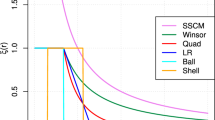Abstract
Centring-then-sphering is a very important pretreatment in data analysis. The purpose of this paper is to study the asymptotic behavior of the sphering matrix based on the square root decomposition (SRD for short) and its applications. A sufficient condition is given under which SRD has nondegenerate asymptotic distribution. As examples, some commonly used and affine equivariant estimates of the dispersion matrix are shown to satisfy this condition. The case when the population dispersion matrix varies is also treated. Applications to projection pursuit (PP) are presented. It is shown that for elliptically symmetric distributions the PP index after centring-then-sphering is independent of the underlying population location and dispersion.
Similar content being viewed by others
References
Anderson, T. W. (1963). Asymptotic theory for principal component analysis, Ann. Math. Statist., 34, 122–148.
Davies, P. L. (1987). Asymptotic behaviour of S-estimates of multivariate location parameters and dispersion matrices, Ann. Statist., 15, 1269–1292.
Fang, K. T. and Zhang, S. T. (1993). The Generalized Multivariate Analysis, The Science Publishing House, Beijing.
Friedman, J. H. (1987). Exploratory projection pursuit, J. Amer. Statist. Assoc., 82, 249–266.
Huber, P. J. (1985). Projection pursuit (with discussions), Ann. Statist., 13, 435–475.
Jones, M. C. and Sibson, R. (1983). What is projection pursuit? (with discussions), J. Roy. Statist. Soc. Ser. A, 150, 1–36.
Li, G. and Zhang, J. (1993). Sphering and its properties, Tech. Report, Institute of Systems Science, Academia Sinica, Beijing.
Maronna, R. A. (1976). Robust M-estimator of multivariate location and scatter, Ann. Statist., 4, 51–67.
Okamoto, M. (1973). Distinctness of the eigenvalues of a quadratic form in a multivariate sample, Ann. Statist., 1, 763–765.
Pollard, D. (1984). Convergence of Stochastic Processes, Springer, New York.
Sun, J. (1989). P-values in projection pursuit, Tech. Report, No. 104, Department of Statistics, Stanford University.
Tyler, D. E. (1982). Radial estimates and the test for sphericity, Biometrika, 69, 429–436.
Tyler, D. E. (1987). A distribution-free M-estimator of multivariate scatter, Ann. Stalist., 15, 234–251.
Tukey, P. A. and Tukey, J. W. (1981). Graphical display of data in three and higher dimensions, Interpreting Multivariate Data (ed. V. Barnet), 195–198, Wiley, New York.
Va der Waerden, B. L. (1949). Modern Algebra l, Ungar, New York.
Zhang, J. (1993a). The asymptotics of two exploratory projection pursuit indices, Chinese J. Appl. Probab. Statist., 9, 18–25.
Zhang, J. (1993b). The maximal affine invariant sphering, Tech. Report, Institute of Systems Science, Academia Sinica, Beijing.
Author information
Authors and Affiliations
About this article
Cite this article
Zhang, J. Data Sphering: Some Properties and Applications. Annals of the Institute of Statistical Mathematics 50, 223–240 (1998). https://doi.org/10.1023/A:1003482914021
Issue Date:
DOI: https://doi.org/10.1023/A:1003482914021




